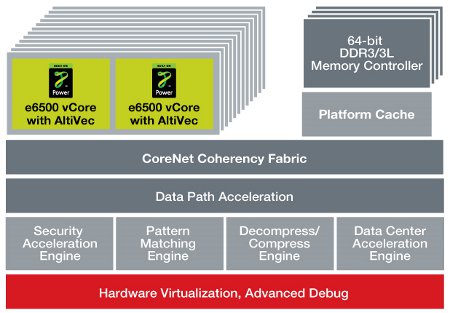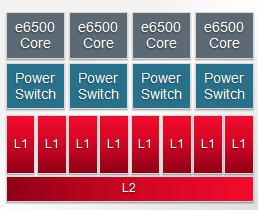Dual-threading QorIQs tap 64-bit, 28nm e6500 core
Jun 21, 2011 — by Eric Brown — from the LinuxDevices Archive — 39 viewsFreescale Semiconductor announced a series of 28nm-fabbed QorIQ multicore processors, featuring a 64-bit PowerPC core clocked up to 2.5GHz. The Linux-ready Advanced Multiprocessing (AMP) QorIQ series will debut in early 2012 with the T4240, offering 12 cores dual-threaded to 24 virtual cores, numerous acceleration engines, and cascading power management, says Freescale.
The QorIQ AMP series offers up to four times the performance of Freescale's eight-core QorIQ P4080 system on chip (SoC), claims Freescale. Like the P5 QorIQ models announced last June, including the single-core QorIQ P5010 and dual-core P5020, the AMP series offers a new 64-bit version of the PowerPC (Power Architecture) core. Yet, while the P5's e5500 cores stayed with the e500 core's 45nm (nanometer) process, the AMP series jumps to a new e6500 core fabricated with 28nm technology.
Like the e5500, the e6500 is said to be capable of clock rates of up to 2.5GHz, although this rate is not claimed for the initial 12-core T4240 AMP SoC. Unlike e5500, however, the E6500 can process more than one thread simultaneously, enabling the execution of dual threads via a combination of shared and dedicated resources. As a result, software can view each core as two virtual cores.

AMP QorIQ block diagram
(Click to enlarge)
Target applications for the AMP series are include familiar territory for QorIQ processors: a "broad array of next-generation control and data plane processors scaling from cost-effective, ultra-low-power single-core products, up to highly advanced SoCs targeting the most demanding networking, industrial, and military/aerospace applications."
Wireless networking infrastructure appears to be the main target. Freescale cites Cisco data saying that global IP traffic will quadruple by 2015 to 966 exabytes per year.
Bringing back AltiVec
The e6500 core integrates an enhanced version of the AltiVec single instruction, multiple data (SIMD) vector processing unit, which has long been available on Freescale's PowerQUICC processors, but did not appear in the next-generation QorIQ line. The new-look AltiVec delivers "DSP-level performance" for high-bandwidth data processing and algorithmic-intensive computations, says the company. More specifically it is claimed to enable an additional 240 GFLOPS of programmable processing performance.
The AMP QorIQ line offers more advanced acceleration engines and co-processing technologies than were supplied by the previous high-end QoriQs, says Freescale. Like the latest P3 and P5 QorIQs, AMP also provides Freescale's Data Path Acceleration Architecture (DPAA) technology, which offers security and pattern-matching technology. Additional pattern-matching engines, as well as a Security with Trust Architecture engine, are also said to be available.
Integrated compression/decompression engines provide 20Gbps of performance, claims the company. The AMP series is also said to add a SEC 5.0 crypto accelerator for offloading protocol processing. This security coprocessor accelerates LTE, IPSec, and SSL communications at up to 40Gbps while delivering nearly 140Gbps of raw crypto hardware acceleration, claims Freescale. Other accelerators are said to include regex acceleration, 128-bit SIMD data prefetching, in-line parsing and classification, and quality of service (QoS).
Technologies carried over from the the P4 QorIQ series include the CoreNet interconnect fabric, as well as a a cache-coherent memory hierarchy, hardware-based virtualization, and dynamic on-chip debug technology, According to Freescale, the AMP processors draw up to 50 percent less power than earlier QorIQ models.
At the core level, efficiency is gained from the E6500's 28nm fabrication process. In addition, engineers can modify individual core frequencies and call upon six core power management states, says the company. A "drowsy" L2 cache is also said to improve core power efficiencies.

AMP power switch architecture
Freescale will offer three tiers of AMP products:
- Control plane processors — Aimed at service provider routers and storage networks, the control plane AMP QorIQs will offer up to six cores running at up to 2.5GHz, says Freescale. L2 cache is said to be greater than 6MB.
- High-end data plane processors — Designed for routers, switches, access gateways, and mil/aero applications, these processors will be led by the initial 12-core (24 virtual core) T4240. This segment of AMP processors will run at up to 2GHz, offer 50Gbps IP forwarding capability, and provide advanced application acceleration, says the company.
- Low-end data plane processors — Suitable for media gateways, network-attached storage (NAS) devices, and integrated services routers, the low-end AMPs will offer up to four cores (eight virtual cores) running at up to 1.6GHz. Features are said to include advanced application acceleration, and power consumption of less than 10 Watts.
The initial, high-end T4240 data plane processor will feature a dozen dual-threaded e6500 cores with 24 threads, says Freescale. Thanks to dual-threading efficiency, improved DMIPs per thread, and a higher frequency, the SoC will provide four times the performance and twice the power efficiency of the QorIQ P4080, claims the company. The T4240 is also said to feature intelligent sharing and duplication of resources between threads, as well as supply a large amount of on-die cache per core.
Linux support by Mentor
The AMP series is software-compatible with the PowerQUICC, QorIQ, and the new 4G basestation-targeted QorIQ Qonverge product families, says Freescale. Development support includes Freescale's CodeWarrior development suite and a third-party ecosystem that includes multiple operating systems, tools, and application software, said to be available starting Q1 2012.
Mentor Graphics was the first company to announce Linux development support for AMP processors. The company, which has become Freescale's go-to vendor for Linux on the QorIQ platform, will offer its Mentor Embedded Linux platform.
Mentor Embedded Linux will be made available with a Freescale reference board, as well as unlimited support for development tools and core open source technologies, according to Mentor. This is said to include access to the latest, stable and compatible open source technology, with updates on new cores, component versions, and defect resolutions furnished twice per year.
Wind River, which is likely to support AMP with both its Wind River Linux and VxWorks distributions, offered a vaguely worded support testimonial. Other testimonials were available from Enea, which offers a Timesys LinuxLink-based Linux support package for the MIPS-based NetLogic Microsystems XLP, XLR, and XLS processors. The company is likely to first announce AMP support with its OSE real-time operating system (RTOS), however.
Green Hills and QNX also pledged support for their respective RTOSes. Testimonials from hardware vendors include support notes from Curtiss-Wright Controls, Emerson Network Power, GE Intelligent Platforms, Mercury Computer Systems, and security appliance vendor WatchGuard.
Stated Glenn Perry, general manager of Mentor Graphics Embedded Software Division, "Freescale's next-generation AMP Series of QorIQ processors, combined with Mentor Embedded software and tools for Linux development, will advance the development of innovative, high-performance, power-efficient multicore products."
Availability
The initial T4240 QorIQ AMP SoC is expected to be made available starting in early 2012, says Freescale. The company plans to introduce additional AMP products during each quarter following the initial product launch. More information on the AMP line may be found on Freescale's QorIQ AMP site.
This article was originally published on LinuxDevices.com and has been donated to the open source community by QuinStreet Inc. Please visit LinuxToday.com for up-to-date news and articles about Linux and open source.